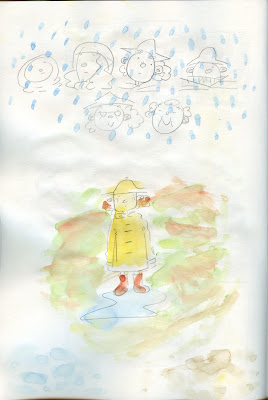Noelline is the protagonist of the story. She was 5 when she had her flood experience.
With this information, Rosie's storyboard and some other insights that I have got as I listen to the soundtrack, I tried to piece them together and create an image of her in my mind as a part of my primary research. I did play around with Rosie's design as well because I agreed with her that Noelline's voice suggests that she is fluffy and friendly. So, what we want is a cuddly, innocent-looking character.


The picture above is the initial sketches of Noelline with variations of style. I thought that the look of the animation should be similar to children's book illustration. Since I do not know what specific book to look for, I just typed 'Rain children storybook' and so I found this book called 'It's Raining Said John Twaining' which has a similar style to what I imagined our animation would be. The juxtaposition of bold yellow jacket to the gloomy background makes the characters stand out. Also, the fluid reflection of the people standing communicates the 'wetness' despite the minimalistic background. This book is the main inspiration for the design of our animation. The reason why I want to make an animation that has an aesthetic of children's book is because I want to convey the lightheartedness from Noelline's voice and her delivery of the story.
 |
| Excerpt from It's Raining Said John Twaining |
This image of a girl chasing a chicken has inspired my design as well. The look is natural and gives off the rural vibes. I tried to find the artist who drew this, but I can't.
For her outfit, I found some vintage Australian kids photos that I found on Google, specifically in the 1920s because that was when the flood happened. The girls wore short sleeved dress most of the time with frills or floral pattern. As for the swimsuit they wear striped vintage swimsuits or a single-coloured one. I tried to match up different designs of Noelline's facial features to the outfit that she wears, and see which one suits her the most. Although the raincoat was the outfit that we think of, I think it will be nice to have her in different kinds of outfit.
 |
| 1920s kids playing in a flooded area |
 |
| Reference Image for Noelline's outfits |
I showed the designs to Tom and Rosie. Tom liked my attempt to imitate Manon Gauthier's squarish face, while Rosie said that rounded face looks better. As for myself, I would go in between, so Noelline's face is more angular because it is easier to copy a drawing with distinct corners rather than a fully rounded one.
I drew her with different strokes as well because I think if I do my strokes downwards, the drawing seems to be looser than when I do it with upwards strokes. It worked better, the lines I got is less bold than when I use varying strokes. However, I decided not to use this idea because it is hard to control the way we stroke our lines.
 |
| Drawings with downwards strokes and less strong lines |
I decided to forsake the mini experiment that I did earlier and keep my strong strokes. I think I found the right face as well now. It was not as squarish as before, and the shapes are not hard to copy as well because of the distinct corners of her face. I kept the big hat that goes with the raincoat because it helps to make her look small.
I discussed the outfit and the character design with Rosie. She liked the vintage dress because it reflects the setting of the story, however she thinks that the yellow raincoat stands out and it fits into the rainy theme better. I do agree with her, on the rainy weather aspects, so I designed Noelline with the raincoat in the end.
As I designed Noelline, I did realised that she talked about a bear stuffed toys, so I did a design for it as well. I am still not sure which design to use, but I liked the snouty nosed design since it works with the flat style we are looking for.






















































